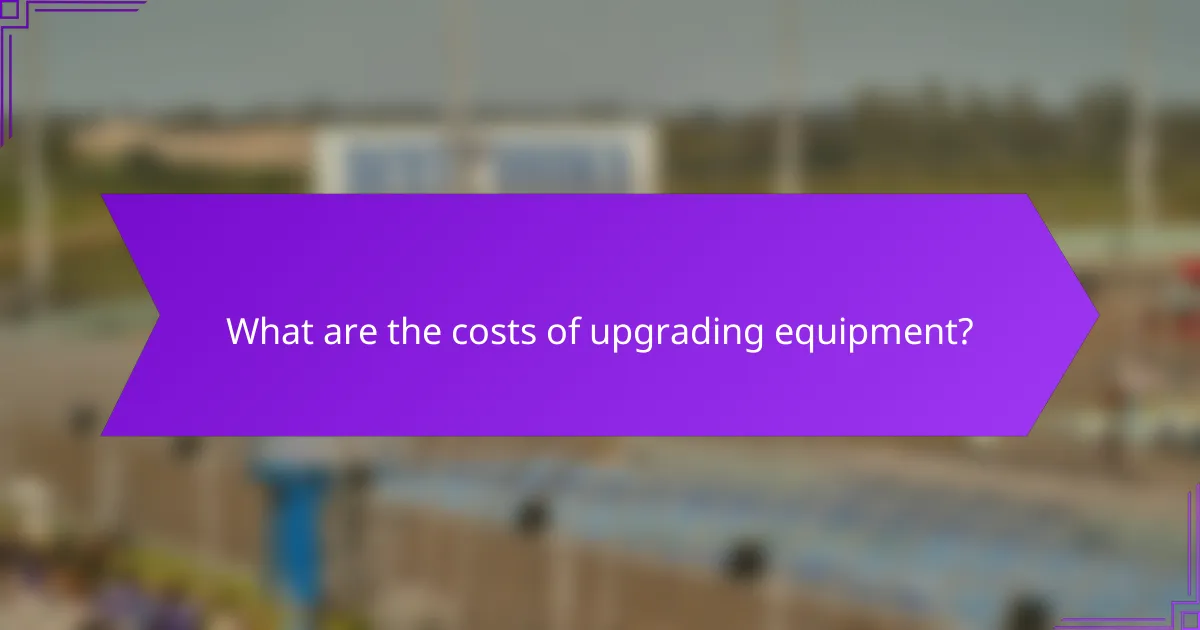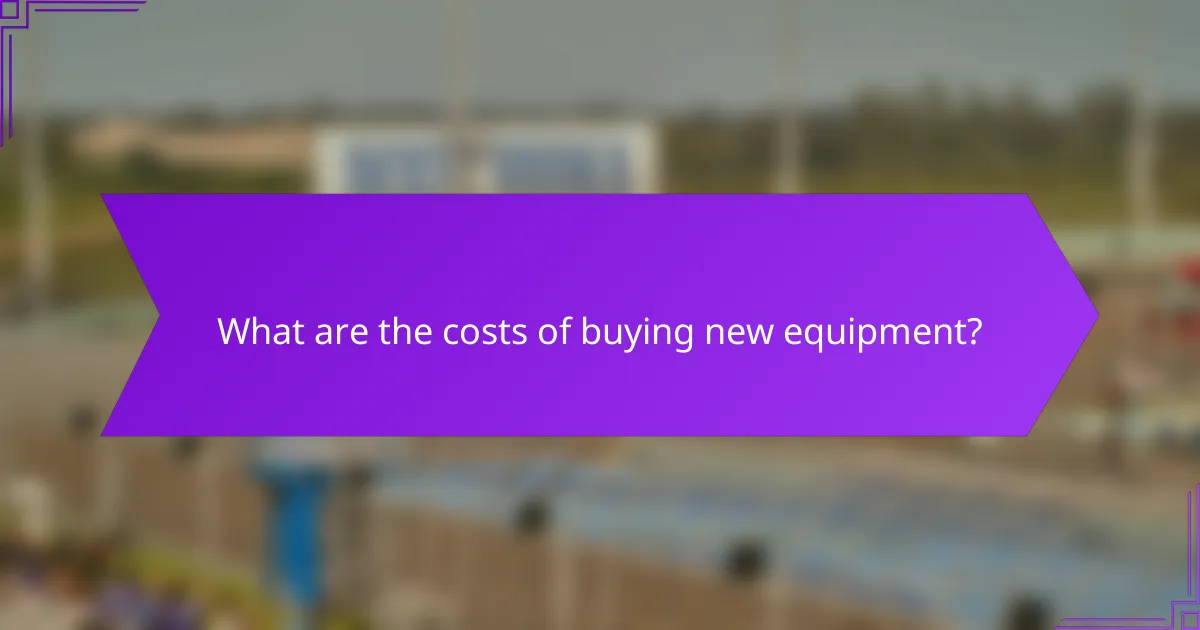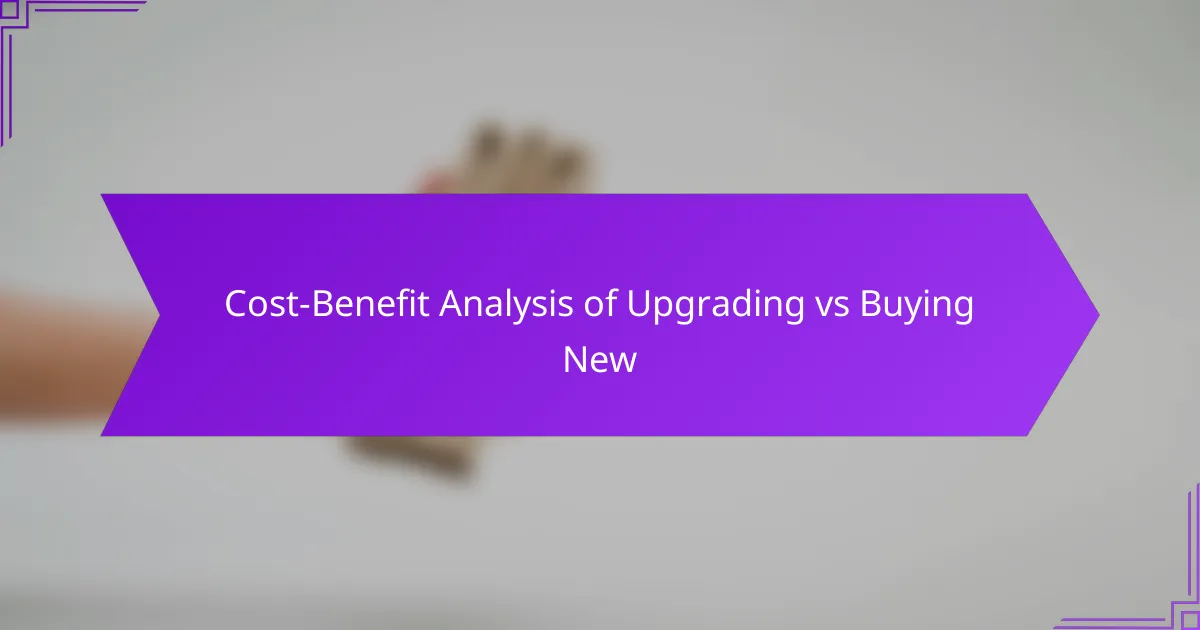When considering whether to upgrade existing equipment or invest in new machinery, a thorough cost-benefit analysis is essential. Upgrading can offer significant performance and efficiency improvements at a lower initial cost, while buying new equipment entails various expenses such as purchase price, installation, and training. Evaluating these factors will help businesses make informed decisions that align with their financial and operational goals.

What are the costs of upgrading equipment?
The costs of upgrading equipment can vary significantly based on the type of equipment and the extent of the upgrades. Key factors include the initial investment, ongoing maintenance expenses, and potential downtime impacts during the upgrade process.
Initial investment
The initial investment for upgrading equipment typically includes the cost of new components, software, and installation services. Depending on the equipment, this can range from a few hundred to several thousand dollars. It’s essential to compare these costs against purchasing new equipment to determine the most cost-effective option.
Consider financing options or leasing arrangements, as these can help spread out the initial costs over time. However, be aware of any interest rates or fees that may apply, as they can increase the overall expenditure.
Maintenance expenses
Upgrading equipment often leads to changes in maintenance expenses. New components may require different maintenance protocols or more frequent servicing, which can increase costs. It’s crucial to assess whether the upgraded equipment will have lower long-term maintenance needs compared to older models.
Additionally, consider the availability of parts and service providers in your area. If upgrades lead to reliance on specialized parts or technicians, this could further elevate maintenance costs.
Downtime impacts
Downtime during equipment upgrades can significantly affect productivity and revenue. The length of downtime can vary based on the complexity of the upgrade, ranging from a few hours to several days. It’s vital to plan upgrades during off-peak times to minimize disruption.
Evaluate the potential financial impact of downtime by estimating lost revenue during the upgrade period. This assessment can help justify the costs associated with upgrading versus purchasing new equipment, as minimizing downtime can lead to better overall efficiency and profitability.

What are the costs of buying new equipment?
Buying new equipment involves several costs that can significantly impact your budget. Key expenses include the purchase price, installation fees, and training costs, all of which should be carefully evaluated before making a decision.
Purchase price
The purchase price is the most obvious cost when acquiring new equipment. This price can vary widely based on the type of equipment, brand, and features, often ranging from a few hundred to several thousand dollars. It’s essential to compare prices from different suppliers to ensure you are getting the best deal.
Consider not only the initial cost but also the long-term value. Higher-priced equipment may offer better durability or efficiency, potentially saving money on repairs and energy over time.
Installation fees
Installation fees can add a significant amount to the overall cost of new equipment. These fees depend on the complexity of the installation and whether professional help is required. For example, installing heavy machinery may require specialized technicians, which can increase costs to hundreds or even thousands of dollars.
To minimize installation expenses, consider whether your team has the skills to handle the setup. If possible, opt for equipment that is easier to install, which can save both time and money.
Training costs
Training costs are often overlooked but are crucial when purchasing new equipment. Employees may need training to operate the new machinery effectively, which can involve direct costs for training sessions or indirect costs due to lost productivity during the learning period. These costs can range from a few hundred to several thousand dollars, depending on the complexity of the equipment.
To mitigate training expenses, look for equipment that comes with comprehensive training resources or consider in-house training options. Investing in proper training can lead to better efficiency and safety in the long run.

What are the benefits of upgrading equipment?
Upgrading equipment can lead to significant improvements in performance, efficiency, and cost savings. By enhancing existing machinery rather than purchasing new, businesses can often achieve better outcomes with lower initial investments.
Improved efficiency
Upgrading equipment typically results in enhanced operational efficiency. Newer technologies often incorporate advanced features that streamline processes, reduce downtime, and increase productivity. For example, upgrading a manufacturing machine may allow for faster production speeds and improved precision.
When considering upgrades, evaluate how much time and resources can be saved. A 10-20% increase in efficiency can make a substantial difference in output and profitability over time.
Extended lifespan
Upgrading equipment can significantly extend its usable lifespan. Regular enhancements and maintenance can prevent obsolescence and keep machinery running smoothly for several additional years. This approach can delay the need for a complete replacement, allowing businesses to maximize their initial investment.
It’s essential to assess the current condition of your equipment and determine which upgrades will provide the most benefit. Simple updates, such as software improvements or new components, can often add years to the life of existing machinery.
Lower operational costs
Upgrading can lead to lower operational costs by improving energy efficiency and reducing maintenance needs. Newer equipment often consumes less power and requires fewer repairs, translating into significant savings over time. For instance, upgrading to energy-efficient models can reduce energy bills by 15-30%.
Consider conducting a cost analysis to compare the long-term savings of upgrading versus the immediate costs of purchasing new equipment. This analysis can help identify the most financially sound decision for your business.

What are the benefits of buying new equipment?
Buying new equipment offers numerous advantages, including access to the latest technology, comprehensive warranties, and potential tax benefits. These factors can significantly enhance operational efficiency and reduce long-term costs.
Latest technology
New equipment typically incorporates the latest technology, which can lead to improved performance and productivity. For instance, modern machinery may operate faster and more efficiently, reducing energy consumption and operational downtime.
Additionally, new models often feature enhanced safety standards and compliance with current regulations, which can mitigate risks associated with older equipment. Investing in the latest technology can also provide a competitive edge in the market.
Warranty and support
Purchasing new equipment usually comes with a manufacturer’s warranty, which can cover repairs and maintenance for a specified period. This warranty can save businesses significant costs associated with unexpected breakdowns or malfunctions.
Moreover, manufacturers often provide ongoing support and training for new equipment, ensuring that staff can operate it effectively. This support can lead to better utilization of the equipment and minimize the learning curve.
Potential tax benefits
Buying new equipment may offer tax advantages, such as depreciation deductions that can reduce taxable income. In some regions, businesses can write off a portion of the equipment cost in the year of purchase, providing immediate financial relief.
Additionally, certain tax incentives may be available for investing in energy-efficient or environmentally friendly equipment. It’s advisable to consult with a tax professional to understand the specific benefits applicable in your jurisdiction.

How to conduct a cost-benefit analysis?
Conducting a cost-benefit analysis involves comparing the costs of upgrading existing systems versus purchasing new ones to determine the most financially sound option. This process helps organizations make informed decisions by evaluating both immediate expenses and long-term advantages.
Identify key metrics
Start by determining the key metrics that will guide your analysis. Common metrics include initial purchase price, maintenance costs, operational efficiency, and potential downtime. These factors will help quantify the financial implications of each option.
Additionally, consider qualitative metrics such as user satisfaction and adaptability to future needs. These elements may not have direct monetary values but can significantly impact overall effectiveness.
Calculate total costs
To calculate total costs, sum all relevant expenses associated with both upgrading and buying new. For upgrades, include costs for hardware, software, labor, and potential disruptions during the transition. For new purchases, factor in the initial price, installation, and any training required for staff.
It’s essential to project these costs over a reasonable timeframe, typically 3-5 years, to capture the full financial impact. This approach allows for a clearer comparison between the two options.
Assess long-term benefits
Evaluating long-term benefits is crucial for understanding the value of each option. Consider factors like increased productivity, reduced maintenance needs, and enhanced capabilities that a new system might offer. These benefits can lead to significant cost savings over time.
When assessing long-term benefits, also account for potential risks and uncertainties. For instance, new technology may offer better performance but could also require more frequent updates or training. Balancing these aspects will provide a clearer picture of the overall value.

What factors influence the decision to upgrade or buy new?
The decision to upgrade existing equipment or purchase new units hinges on several key factors, including the current condition of the equipment, cost implications, and the specific needs of the business. Evaluating these elements helps determine the most cost-effective and efficient option for operations.
Current equipment condition
Assessing the current condition of equipment is crucial when deciding whether to upgrade or buy new. If the equipment is still functional but showing signs of wear, an upgrade might extend its life at a lower cost than purchasing new. Conversely, if the equipment frequently breaks down or lacks essential features, investing in new units may be more prudent.
Consider conducting a thorough inspection of the equipment to evaluate its performance, maintenance history, and any required repairs. A general rule of thumb is that if repair costs exceed 50% of the replacement cost, it may be time to consider buying new. Additionally, consider how well the current equipment meets your operational needs; outdated technology can hinder productivity.



